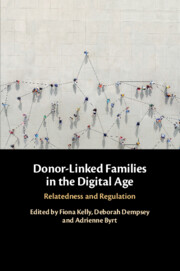Book contents
- Donor-Linked Families in the Digital Age
- Donor-Linked Families in the Digital Age
- Copyright page
- Dedication
- Contents
- Tables
- Contributors
- Acknowledgements
- Donor-Conceived Families
- Part I ‘DIY’ Donor Linking: Issues and Implications
- Part II Children’s and Adults’ Lived Experiences in Diverse Donor-Linked Families
- Chapter 6 The Importance of Donor Siblings to Teens and Young Adults
- Chapter 7 The Experiences of Donor-Conceived People Making Contact with Same-Donor Offspring through Fiom’s Group Meetings
- Chapter 8 ‘It’s All on Their Terms’
- Chapter 9 On Familial Haunting
- Chapter 10 Assisted Reproduction and Making Kin Connections between Māori and Pākehā in Aotearoa New Zealand
- Chapter 11 ‘Spunkles’, Donors, and Fathers
- Part III Institutionalised Resistance to Openness
- Index
- References
Chapter 7 - The Experiences of Donor-Conceived People Making Contact with Same-Donor Offspring through Fiom’s Group Meetings
from Part II - Children’s and Adults’ Lived Experiences in Diverse Donor-Linked Families
Published online by Cambridge University Press: 13 July 2023
- Donor-Linked Families in the Digital Age
- Donor-Linked Families in the Digital Age
- Copyright page
- Dedication
- Contents
- Tables
- Contributors
- Acknowledgements
- Donor-Conceived Families
- Part I ‘DIY’ Donor Linking: Issues and Implications
- Part II Children’s and Adults’ Lived Experiences in Diverse Donor-Linked Families
- Chapter 6 The Importance of Donor Siblings to Teens and Young Adults
- Chapter 7 The Experiences of Donor-Conceived People Making Contact with Same-Donor Offspring through Fiom’s Group Meetings
- Chapter 8 ‘It’s All on Their Terms’
- Chapter 9 On Familial Haunting
- Chapter 10 Assisted Reproduction and Making Kin Connections between Māori and Pākehā in Aotearoa New Zealand
- Chapter 11 ‘Spunkles’, Donors, and Fathers
- Part III Institutionalised Resistance to Openness
- Index
- References
Summary
More and more donor-conceived people are interested in, and in contact with, same-donor offspring. Moreover, donor-conceived people can find large numbers of same-donor offspring, enabled by more openness regarding donor conception, social media, donor registers and (online) DNA testing. The impact of meeting large numbers of same-donor offspring has not yet been explored. At Fiom, a Dutch organisation providing independent support in the search for biographical information, we conducted a qualitative study interviewing 19 donor-conceived people who participated in same-donor offspring group meetings. Data showed that while relationships between same-donor offspring are commonly experienced as more beneficial than connecting with the donor, they also come with challenges such as how to integrate these new relations into their lives, how to manage group dynamics and a continuously growing network. Data revealed a need for counselling tailored to the context of multiple same-donor offspring contact. Lastly, challenges for regulators are discussed.
- Type
- Chapter
- Information
- Donor-Linked Families in the Digital AgeRelatedness and Regulation, pp. 120 - 137Publisher: Cambridge University PressPrint publication year: 2023

